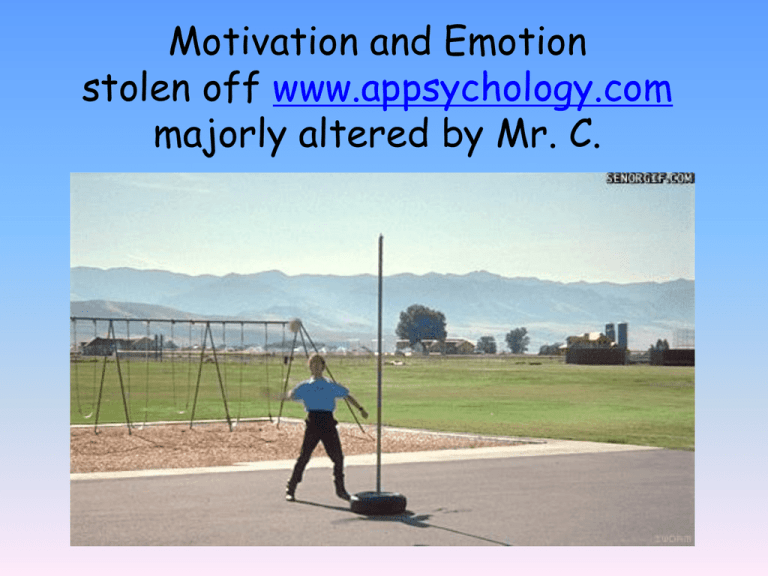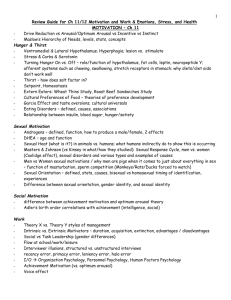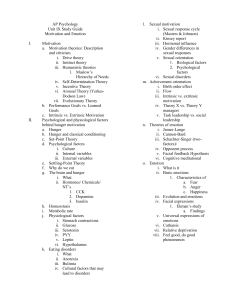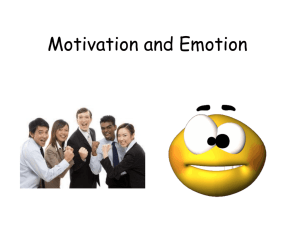Motivation and Emotion stolen off www.appsychology.com majorly
advertisement

Motivation and Emotion stolen off www.appsychology.com majorly altered by Mr. C. A need or desire that energizes behavior and directs it toward a goal Motivation • Instinct Theory (evolutionary): we are motivated by our inborn automated behaviors. – Genes predispose species-typical behavior (reflexes) • But instincts only explain why we do a small fraction of our behaviors. Drive Reduction Theory • Our behavior is motivated by BIOLOGICAL NEEDS. • Wants to maintain homeostasis. • When there is both a need and an incentive, we feel strongly driven • Eating, drinking, hot or cold, using the restroom Arousal Theory • We are motivated to seek an optimum level of arousal. • We feel drive to experience stimulation and we hunger for information • Lacking stimulation we fill bored, too much we may feel stressed Yerkes-Dodson Law • The Yerkes-Dodson Law says we perform best under the optimal amount of arousal. (Like Goldilocks) • Not too much, not too little. Maslow’s Hierarchy of Needs • Abraham Maslow said we are motivated by needs, and all needs are not created equal. • We are driven to satisfy the lower level needs first. Motivation of HUNGER Biological Basis of Hunger • Hunger does NOT come from our stomach. It comes from our… • Brain – The Hypothalamus Hypothalamus Lateral Hypothalamus • When stimulated it makes you hungry. • When lesioned (destroyed) you will never be hungry again. Ventromedial Hypothalamus • When stimulated you feel full. • When lesioned you will never feel full again. Set Point Theory • The hypothalamus acts like a thermostat. • Wants to maintain a stable weight. • Activate the lateral when you diet and activate the ventromedial when you start to gain weight. • Setting point: weight response to caloric intake • Leptin theory Body Chemistry • Glucose • The hormone insulin converts glucose to fat. • When glucose levels drop- hunger increases. Psychological Aspects of Hunger • Internals versus Externals • People eat more when eating with others • People tend to overeat “free snack” • The Garcia Effect-taste aversion Culture and Hunger neopohbiadislike of things unfamiliar Hot cultures like hot spices (more bacteria-inhibiting spices) Dog Mice Wine Fried Frog Legs Criadillas- bull testicles. Eating Disorders Bulimia Nervosa • Characterized by binging (eating large amounts of food) and purging (getting rid of the food). Anorexia Nervosa • Starve themselves to below 85% of their normal body weight. • See themselves as fat. • Vast majority are women. Eating disorders • Anorexia sufferers often have low self-evaluations, perfectionist standards, expectations, and concerned with how others perceive them • Cultural and Gender components (genetics may influence susceptibility) • Western culture-weight-obsessed society • African-plumpness signaled as having money and being healthy (not having aids or being hungry) Obesity • Severely overweight to the point where it causes health issues. • Mostly eating habits but some people are predisposed towards obesity. Click on the pictures to see some case studies on obesity. Obesity and Weight control • WHO (2007) more than 1 billion people are overweight and 300 million are obese • Global epidemic of diabetes • Obesity increases the risk of diabetes, high blood pressure, heart disease, gallstones, arthritis, certain cancers • BMI-considers height as well – Doesn’t consider metabolism, blood pressure, cholesterol levels, or muscle mass Social Effects of Obesity and the Physiology of Obesity • Gender and weight discrimination in the work place • Lower psychological well-being • Size of fat cells increase not number • Dramatic drop in caloric intake decrease metabolism (body adapts to starvation) • Genes somewhat at play: when to signal the body that its full or how efficiently we burn calories Food Facts and Weight Loss • Social influence • Sleep loss • Lifestyle choices: inactivity combined with larger portions • Set realistic goals • Exercise regularly • Keep junk food out of the house • Eat consistently (healthy foods) • Watch portions (plates/bowls) Sexual Motivation • Sex is natural. • Without sex, none of us would be here. • Less influenced by biological and more psychological and socialcultural factors (compared to food) • How do scientists (or you) find out about sex? YOU ASK!!!!!! Mapped out the Sexual Response Cycle • • • • Initial Excitement Plateau Phase Orgasm Resolution Phase (with refractory period). Hormones and Sexual Behavior • Sexual desire rises slightly at ovulation among women with mates • Both men and women secrete sex hormones but men secrete more______________ and women more_____________ • In men, testosterone levels have little effect on sexual desire • Biology is necessary but not sufficient explanation of human sexual behavior The Psychology of Sex • External – Sexual explicit material (negative effects) – Depictions of women being sexually coerced and enjoying tend to increase viewer’s acceptance of rape – Devalue their own partners – Diminish their own sexual satisifcation • Imagine Stimuli – The brain is the most significant sex organ and can influence sexual arousal and desire – Sexual fantasies are healthy Adolescent Sexuality • 2005, 47% of high school students acknowledge having had sexual intercourse • Sex during teen years is often unprotected • Teen pregnancy: ignorance, minimal communication of birth control, guilt related to sexual activity, alcohol use, mass media norms of unprotected promiscuity • 2/3 of new STI’s occur in people under 25 • Teens who delay – – – – Higher intelligence Religious engagement Father presence Participation in service learning programs Kinsey’s Studies • Confidential interviews with 18,000 people (in early 1950’s). • Sexual Behavior in the Human Male and Sexual Behavior in the Human Female • Scale of sexuality….0 to 6 where 0 is exclusively heterosexual and 6 homosexual and 7 is asexual. Click on Kinsey to see the movie trailer. Masters and Johnson Study • In the 1960’s William Masters and Virginia Johnson set out to explore the physiology of sex. • 382 females and 312 males. After their research was done they ran an institute that claimed to turn gay people straight. Sexual Orientation An enduring sexual attraction toward members of either one's own gender or the other gender. Most of today’s psychologists view sexual orientation as neither willfully chose nor willfully changed How is Sexual Orientation Determined • There has been NO evidence that sexuality is socially determined. • Kids raised by gay parents are no more likely to be gay that if they were raised by hetero parents. • This it is likely biologically determined. Origins of Sexual Orientation • Homosexual people do appear more often in certain populations or job occupations (poets, writers, artists, musicians) • Men who are right-handed and have older brothers are somewhat more likely to be gay (fraternal birth order effect) – Blanchard suspects that with each male pregnancy, the maternal antibodies may become stronger and prevent the fetus’ brain from developing a male-typical pattern • Same sex attraction in animals: grizzlies, gorillas, monkeys, flamingos, and owls The Brain • Simon LeVay discovered that there is a cluster of cells in the hypothalamus that is larger in heterosexual men than in heterosexual women or homosexual men. • He believes it is more likely that brain anatomy influences sexual orienatation • Gay men and straight women have brain hemispheres of similar size Genes and Sexual Orientation • Evidence does indicate a genetic influence on sexual orientation • Homosexuality appears to run in families • Biological correlates of sexual orientation (page 358) – Gay men spatial abilities resemble those of straight women – Straight women and gay men outperform straight men at remembering object’s spatial locations Prenatal Environment • Current research seems to point to the hormonal levels in the prenatal environment. • Exposure to hormones in the middle of the second and fifth months after conception appears to predispose the person to be attracted to males or females later in life • We have created homosexual male fruit flies and lesbian sheep!!! The need to belong • Wanting to belong – What makes life meaningful? Family, friends, romantic partners – When we feel included, accepted, and loved by those important to us, self-esteem rides high – The need to belong feeds both deep attachments and menacing threats • Aiding survival – Social bonds boosted our ancestors’ survival rate The need to belong • Sustaining relationships – After separations, feelings of loneliness, anger, and desire to be near the person lingers (relationship example) – When something threatens our social ties, negative emotions (anxiety, loneliness, jealousy, guilt) overwhelm us (college example) • The pain of Ostracism (social exclusion) – To experience ostracism is to experience real pain • Triggers activity in the brain that activates real pain – Rejected and unable to remedy the situation, people may turn to selfdefeating behavior, underperform on aptitude tests, less empathetic for others, more likely to act in aggressive ways (school violence, bullying example) Achievement Motivation What motivates us to work? (School, job, sports, video games, relationships etc..) Intrinsic Motivators • Rewards we get internally, such as enjoyment or satisfaction. Extrinsic Motivators • Reward that we get for accomplishments from outside ourselves (grades or money or etc..) • Work great in the short run. Achievement motivation • Those with high achievement motivation will choose tasks that are moderately difficult. Not too hard because they want to achieve. Not too easy because they want to feel good about themselves. Where would one stand to practice if they had high achievement motivation? Overjustification effect Studies show that if you externally reward someone (excessively) for something they love doing, they will lose their intrinsic desire for doing it. • Alex Rodriguez earns 27.5 million dollars per year. Does he love the game?? Management Theory Management/Teaching styles relate closely to Intrinsic/Extrinsic Motivators. Theory X • Managers believes that employees will work only if rewarded with benefits or threatened with punishment. • Think employees are Extrinsically Motivated. • Only interested in Maslow’s lower needs. Theory Y • Managers believe that employees are internally motivated to do good work and policies should encourage this internal motive. • Interested in Maslow’s higher needs. When Motives Conflict • Approach-approach conflict – when we have 2 desirable things to choose from. Both Beyonce and Tyra Banks want to date you. Approach –avoidance conflict • Both options have their benefits and drawbacks. Example, telling your wife that her hair looks bad. The good is she’ll fix it. The bad is she might be mad at you for a few hours. Avoidance-avoidance conflict • You must choose between 2 equally unattractive options. Four theories of emotion James-Lange Theory of Emotion • Willam James and Carl Lange came up with the James-Lange Theory of Emotion. • Based on our autonomic nervous system • The body changes and our mind interprets those changes as emotion. • “I’m afraid because I run” • Male participants were asked to meet an interviewer in the middle of one of two bridges. One was a safe-looking bridge and one looked more dangerous. An attractive female researcher interviewed the male passers-by in the middle of the two bridges. She gave them her telephone number in case they wanted to ask about the results. Men on the less safe-looking bridge were more aroused by the height of the bridge, and were likely to confuse their feelings for being 'lovestruck'. They were then more likely to call her back, looking for a date. • Support for James Lange???? 47 • Giving the Finger, the Psychology and History Thereof By William Weir on February 13, 2009 • For the study, 54 right-handed subjects read a story about a person whose behavior could be interpreted as either assertive or hostile. One group extended their forefinger while reading, another group extended their middle finger. The latter group tended to assert that person in the essay was hostile, rather than assertive. • Support for the James Lange theory?? 48 Facial feedback hypothesis 49 The Effects of Facial Expression If facial expressions are manipulated, like furrowing brows, people feel sad while looking at sad pictures. Courtesy of Louis Schake/ Michael Kausman/ The New York Times Pictures Attaching two golf tees to the face and making their tips touch causes the50brow to furrow. Maybe Ned was right. Sometimes we should force ourselves to smile. Cannon-Bard Theory of Emotion • Say JamesLange theory is full of crap. • The physiological change and cognitive awareness must occur simultaneously. • They believed it was the thalamus that helped this happen. Think – 2 cannons firing at the same time. Physiological change (heart rate, breathing) Cognitive awareness Two-Factor Theory of Emotion • Stanley Schachter explains emotions more completely that the other two theories. • They happen at the same time but… • Emotion is processed in the autonomic nervous system AND the cerebral cortex (conscious thought) • Includes cognitive appraisal • If you are in a falling vehicle heading toward the ground at 60 mph, your autonomic reaction would include heart racing and screaming. But if your cognitive appraisal says you are on a rollercoaster, then you have the emotion of “fun” Everyone say it loud Schacter – Two Factor Opponent Process Theory of Emotion • Have you ever felt crappy for a few days, then felt elated? This theory says feeling one way will lead you to feel the opposite. • How is this similar to the opponent process theory of color vision? Stress • There are 2 stress hormones you need to know. • Cortisol and adrenaline • Cortisol does lead to weight gain. Seyle’s General Adaptation Syndrome • Describes our response to a stressful event. • Three stages 1. Alarm 2. Resistance 3. Exhaustion Emotional Expression When culturally diverse people were shown six basic facial expressions, they did fairly well at recognizing them (Paul Ekman 1989). Elkman & Matsumoto, Japanese and Caucasian Facial Expression of Emotion 60 Izard (1977) isolated 10 emotions. Most of them are present in infancy, except for contempt, shame, and guilt. Even blind children display these facial expressions. Tom McCarthy/ Rainbow Patrick Donehue/ Photo Researchers, Inc. Bob Daemmrich/ The Image Works Nancy Brown/ The Image Bank Marc Grimberg/ The Image Bank Michael Newman/ PhotoEdit Lew Merrim/ Photo Researchers, Inc. 61 Paul Ekman – basis for Lie to Me • Paul Ekman studied emotions and facial expressions and found there are universal facial expressions. Lying and disgust are the same in the USA and Japan. • However, the display rules are different for collectivist cultures than individualist cultures. Chinese are not encouraged to display anger like Americans are. 62 Cognition Does Not Always Precede Emotion When fearful eyes were subliminally presented to subjects, fMRI scans revealed higher levels of activity in the amygdala (Whalen et al. 2004). Courtesy of Paul J. Whalen, PhD, Dartmouth College, www.whalenlab.info 63 Catharsis Hypothesis Venting anger through action or fantasy achieves an emotional release or “catharsis.” Expressing anger breeds more anger, and through reinforcement it is habit-forming. 64 Cultural & Gender Differences 1. 2. Boys respond to anger by moving away from that situation, while girls talk to their friends or listen to music. The expression of anger is more encouraged in individualistic cultures (USA) than in cultures that do promote group behavior (China, Japan) Wolfgang Kaehler 65 Predictors of Happiness Why are some people generally more happy than others? 66





